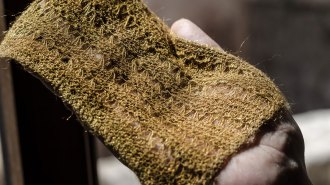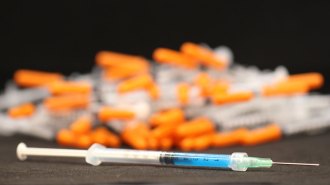A killer paint job
Nanoparticles in paint possible ‘superbug’ fighter
- More than 2 years ago
Scientists may soon shed light on a way to conquer “superbugs” with nanotechnology and a simple flip of a switch.
A new type of paint for walls and ceilings may, when exposed to fluorescent light, be able to kill “superbugs,” antibiotic-resistant bacteria, according to preliminary studies led by Lucia Caballero from ManchesterMetropolitanUniversity in England. Many paints are infused with titanium dioxide for its brightening power. But when these particles are small, on the nanoscale of a billionth of a meter, they have more surface area exposed to light. As a result, they create a more reactive environment. When paint infused with titanium dioxide nanoparticles absorbs fluorescent light, the light destabilizes the particles. This causes them to react with water molecules and form hydroxyl radicals, which in turn corrode the membranes of bacteria and viruses, rendering them inactive. In lab experiments by Caballero’s team, the paint killed the food poisoning bacterium Escherichia coli within 96 hours, Caballero reported September 10 in Dublin at the fall Society for General Microbiology conference. Caballero hopes that this technology will eventually lower the costs of cleaning maintenance and address rising concerns about the spread of antibiotic-resistant bacteria in hospitals. An estimated 94,360 U.S. patients developed an invasive infection from antibiotic-resistant Staphylococcus aureus (MRSA) in 2005, and nearly one of every five of those patients died. Titanium dioxide is a white brightener in commercial paints and in the base powder used to draw lines on tennis courts. White paint usually contains about 20 to 30 percent titanium dioxide in combination with fillers. Caballero’s paint, however, had high concentrations — up to 80 percent — that make it reactive in fluorescent light. Glass or ceramics coated with titanium dioxide are currently on the market, Caballero says, but the breakthrough of her research is that the “bacteria can be inactivated with photocatalyst paint under fluorescent lamps used in our daily life.” “The idea of fighting bacteria with paint is not new,” says Sally Ramsey, the founder and vice-president of product development of NaturalNano, Inc., a Rochester, N.Y.-based nanotechnology company that markets a mold-fighting nanotechnology coating. Her concern is that “anything that survives and sticks around grows greater resistance … ultimately it will be its own worst enemy and the bacteria could grow to be even stronger,” she said. Still, Caballero’s paint will not be featured on store shelves within the near future. Commercially available paints contain additives that decrease the antibacterial properties of the nanotechnology paint. One such filler, calcium carbonate, was shown to decrease the bacteria-fighting powers of titanium dioxide by 80 percent. Caballero and her colleagues are working on replacements for these substances but, she says, at this time “decreasing the additives means poor quality [paint].” Joe Crudden, the senior scientist for Agion Technologies, Inc., a company that works on antimicrobial agents, points out that “ordinary titanium dioxide would be about 10 times as expensive as calcium carbonate. So price would be a consideration.” Using nanoparticles in paint is a growing area of exploration. Companies have financed tests for scratch-resistant paint for cars, anti-corrosive and thermal-insulating coatings for underwater oil and gas pipelines, and even experimental paint that could block cell phone signals.






